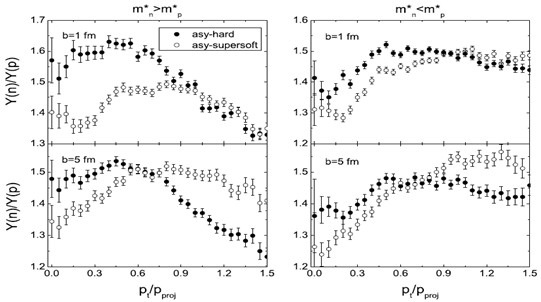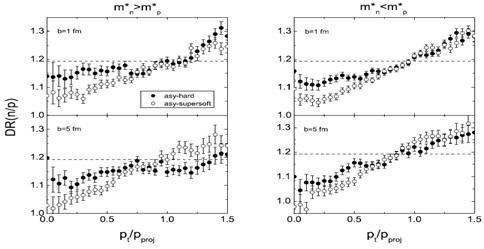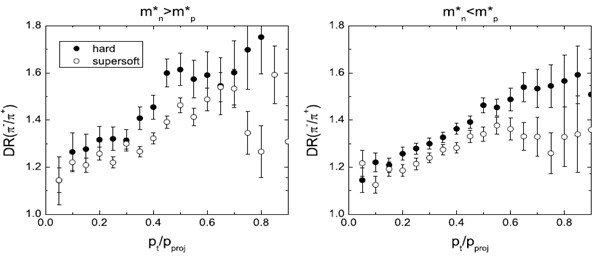High-density symmetry energy plays an important role on the issues of astrophysics, such as the structure of neutron star, the nucleosynthesis during supernova explosion of massive stars etc. Up to now, the knowledge of the isospin asymmetric nuclear matter at high densities is very limited. High-energy heavy-ion facilities, such as the Cooling Storage Ring at Heavy Ion Research Facility in Lanzhou (HIRFL-CSR), provide platform to explore the high-density behavior of compressed nuclear matter.
Within an isospin and momentum dependent transport model developed at Institute of Modern Physics, Chinese Academy of Sciences (IMP), researchers studied transverse emission of pre-equilibrium nucleons, light clusters and charged pions from the isotopic 112,124Sn+112,124Sn reactions at a beam energy of 400 A MeV.
The result shows that the transverse momentum distribution of isospin ratios strongly depends on the stiffness of nuclear symmetry energy, which would be a nice observable to extract the high-density symmetry energy. The observables in this calculation are valuable for constraining the high-density behavior of the nuclear symmetry energy in the near future experiment. The collision centrality and the mass splitting of neutron and proton in nuclear medium play significant roles on the distribution structure of the ratios, but do not change the influence of symmetry energy on the spectrum.
This research has been published in Physics Letters B 707 (2012) 83. This work was supported by the National Natural Science Foundation of China under Grant Nos 10805061 and 11175218, and the Advancement Society of Young Innovation of Chinese Academy of Sciences.
The article is linked as follows: http://www.sciencedirect.com/science/article/pii/S0370269311014444

Fig.1 Transverse momentum distributions of neutron/proton ratio of free nucleon emissions within the rapidity bin |y/yproj|<0.3 in the 124Sn+124Sn reaction at incident energy of 400 MeV/nucleon for near-central (b=1 fm) and semi-central (b=5 fm) collisions with the mass splittings of m*n>m*p and m*n<m*p, respectively. (Image by IMP)


Fig.2 The double neutron/proton and π-/π+ ratios taken from the reactions of 112Sn+112Sn and 124Sn+124Sn at an incident energy of 400 MeV/nucleon. (Image by IMP)

